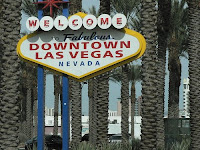
What can you say about Las Vegas that its tourist board hasn't already? Spanish for "the meadows," Las Vegas was best known in the 1800s as a stop on the Mormon Trail. Perhaps a sign of things to come, in 1861 a gold strike brought prospectors. The Civil War brought Nevada into the Union as part of the Arizona Territory, and it gained its own statehood in 1867. Three thousand people showed up in 1905 to buy land here that the Union Pacific Railroad was auctioning. In 1931, Nevada became the first state to legalize gambling, the same year that the Hoover Dam project started as part of the Depression-era public works programs. That community remains the only one in Nevada that prohibits gambling, a holdover from the feds' anti-gaming policy.
Las Vegas is now known for "tourism," which rally means gambling: $6 billion worth each year that attracts 35 million people. The casinos in turn fuel the burgeoning of a favorite Hopper subject: hotels. The Strip was home to 13 of the world's 15 biggest hotels. The four at the corner of Tropicana Avenue and The Strip offered more hotel rooms than all of San Francisco.
Unlike Hopper's tiny, cookie-cutter, faceless dumps, these behemoths strive for exotic uniqueness. Las Vegas was littered with icons ransacked from every culture, including our own. It is odd to see the Eiffel Tower next to the Pyramids next to the New York skyline--and all of it in the middle of nowhere. It's Hopperesque.
Many of the hotels' themes were Hopper's themes as well. "Circus Circus" was like Hopper's theater paintings  . "Mandalay Bay" reproduced a beach within its walls, but it was not at all like Hopper's Cape Cod beaches. He lived in "New York, New York" and loved "Paris."
. "Mandalay Bay" reproduced a beach within its walls, but it was not at all like Hopper's Cape Cod beaches. He lived in "New York, New York" and loved "Paris."
On Hopper's behalf, I had to visit Paris--the casino.  A five-story, Second Empire building, it was home to "Le Mon Ami Gabie, a French Steakhouse." The real French don't eat steak; they eat horse. But this wasn't Paris, but what Americans associated with Paris: a balloon, the Eiffel tower, a mansard roof, and the French-sounding name of the star act: Patti LaBelle. No pissoirs here (the public toilets that dot Parisian boulevards). Hopper was fascinated in Paris with the ability to look at life's sordidness, like the dead men washed up out of the Seine. Gawking was something Paris and Vegas had in common. Plenty of places in Vegas reminded me of Hopper's
A five-story, Second Empire building, it was home to "Le Mon Ami Gabie, a French Steakhouse." The real French don't eat steak; they eat horse. But this wasn't Paris, but what Americans associated with Paris: a balloon, the Eiffel tower, a mansard roof, and the French-sounding name of the star act: Patti LaBelle. No pissoirs here (the public toilets that dot Parisian boulevards). Hopper was fascinated in Paris with the ability to look at life's sordidness, like the dead men washed up out of the Seine. Gawking was something Paris and Vegas had in common. Plenty of places in Vegas reminded me of Hopper's  Girlie Show.
Girlie Show.
At the end of The Strip, easily overlooked, was the town's post office. I figured locals would have to come here, and in fact I found a local working there. She was an African American woman with a big warm face. When I asked if people were isolated here, she said, "Some is. We have to stick together because there aren't many of us who were born and raised here. Those of us who have been, we all know each other. So you see each other and you say hi. I like walking down the street and saying hi to people. A lot of people in other cities, they won't even say hi to you or acknowledge you as you walk down the street."
There was a Las Vegas beyond The Strip. The roads were only a little less wide, and the only thing "strip" were the malls. Half of the town's current residents weren't here ten years ago. A popular local adage states that "Nothing ever changes in Las Vegas--except the way it looks and the people who live here." A Las Vegas Web site tried to dispel some myths about locals by noting: "We don't live in hotels. Not all Vegas women are showgirls. No one wants your kidneys." I met one of the people who lived here on the plane ride out here, a burly, red-haired construction worker named Dwayne. At the time, right after 9/11, we still looked around to find the large, athletic-looking males on any flight.
"For every hotel room they build," Dwayne measured, "they create five jobs. People will come out here [to Las Vegas] for construction jobs from Los Angeles, make twelve hundred in a week, lose four hundred of it in the gambling, and then have to go home and explain what happened to the wife."
"The town's finally becoming big enough where there are casinos that are marketed to the locals rather than to the tourists. It's an unusual city in that it's open twenty-four hours a day. So you have three shifts of people working eight hours a day, and therefore at any one point in time, you're only going to have access to one-third of the population. It also means traffic is bad all day long."
20090405
204 Las Vegas, NV: Strip
Subscribe to:
Post Comments (Atom)




No comments:
Post a Comment